Evaluation of Flexural Behavior of Prestressed Concrete (PSC) Hollow-Core Slabs (HCSs)
Abstract
:1. Introduction
Research Significance
2. Major Structural Design Criteria of PS-HCS
Flexural Strength
3. Test Program
3.1. Materials
3.2. Design of Specimens
3.3. Test Setup
4. Results and Discussion
4.1. Load–Displacement Relationship
4.2. Crack Pattern
4.3. Flexural Strength
4.4. Strain Distribution
5. Conclusions
Author Contributions
Funding
Data Availability Statement
Acknowledgments
Conflicts of Interest
Nomenclature
| Mu | Ultimate flexural strength of HCS |
| Mn | Nominal flexural strength of HCS |
| Mcr | Flexural crack strength of HCS |
| fr | Flexural crack strength of concrete |
| Compressive strength of concrete | |
| Sb | Section modulus from the neutral axis to the bottom of the section |
| Pe | Effective tension of tension material |
| a | Depth of equivalent stress block |
| As | Cross-sectional area of tension reinforcement |
| e | Distance from the neutral axis of the section to the center of the tendon |
| fps | Tensile strength of tension tendon |
| fpu | Yield tensile strength of tension tendon |
| Coefficient according to the type of tendon | |
| Diameter of transverse bar between centers | |
| rc | Section secondary radius |
| Distance from the compression edge to the center of the tension bar cross section | |
| Distance from the compressed edge to the center of the tension member | |
| Steel index of tensile rebar | |
| Steel index of compressed rebar | |
| fy | Yield strength of logitudinal rebar |
References
- Lee, Y.J.; Kim, H.K.; Kim, M.J.; Kim, D.H.; Kim, K.H. Shear Performance for Prestressed Concrete Hollow Core Slabs. Appl. Sci. 2020, 10, 1636. [Google Scholar] [CrossRef]
- Becker, R.J.; Buettner, D.R. Shear tests of extruded hollow-core slabs. PCI J. 1985, 30, 40–54. [Google Scholar] [CrossRef]
- Hawkins, N.M.; Ghosh, S.K. Shear strength of hollow-core slabs. PCI J. 2006, 51, 110–114. [Google Scholar]
- Pajari, M. Web shear failure in prestressed hollow core slabs. J. Struct. Eng. 2009, 42, 83–104. [Google Scholar]
- Palmer, K.D.; Schultz, A.E. Factors affecting web-shear capacity of deep hollow-core units. PCI J. 2010, 55, 123–146. [Google Scholar] [CrossRef]
- Palmer, K.D.; Schultz, A.E. Experimental investigation of the web-shear strength of deep hollow-core units. PCI J. 2011, 56, 83–104. [Google Scholar] [CrossRef]
- Lee, Y.J.; Kim, H.K.; Kim, M.J.; Lee, J.S.; Kim, K.H. Evaluation of structural performance for prestressed concrete hollow core slabs. J. Korea Concr. Inst. 2019, 31, 505–512. (In Korean) [Google Scholar] [CrossRef]
- Ueda, T.; Stitmannaithum, B. Shear Strength of Precast Prestressed Hollow Slabs with Concrete Topping. ACI Struct. J. 1991, 88, 402–410. [Google Scholar]
- Pajari, M. Resistance of Prestressed Hollow Core Slabs Against Web Shear Failure; Technical Research Centre of Finland (VTT): Espoo, Finland, 2005. [Google Scholar]
- Walraven, J.C.; Mercx, W.P.M. The bearing capacity of prestressed hollow-core slabs. Heron 1983, 28, 1–46. [Google Scholar]
- TNO Building and Constructions Research. TNO Report: Standard Shear Tests on Prestressed Hollow Core Slabs According to EN 1168; TNO Building and Constructions Research: Hague, The Netherlands, 2005. [Google Scholar]
- Bertagnoli, G.; Mancini, G. Failure analysis of hollow-core slabs tested in shear. Struct. Concr. 2009, 10, 139–152. [Google Scholar] [CrossRef]
- Celal, M.S. Shear Behavior of Precast/Prestressed Hollow-Core Slabs. Master’s Thesis, University of Manitoba, Winnipeg, MB, Canada, 2011. [Google Scholar]
- Park, M.K.; Lee, D.H.; Han, S.J.; Kim, K.S. Web-shear capacity of thick precast prestressed hollow-core slab units produced by extrusion method. Int. J. Concr. Struct. Mater. 2019, 13, 19–32. [Google Scholar] [CrossRef]
- Lee, D.; Park, M.-K.; Joo, H.-E.; Han, S.-J.; Kim, K.S. Strengths of Thick Prestressed Precast Hollow-Core Slab Members Strengthened In Shear. ACI Struct. J. 2020, 117, 129–140. [Google Scholar]
- Imjai, T.; Suthiprabha, S.; Figueiredo, F.P.; Garcia, R. Strengthening of Hollow Core Slabs to Reduce Excessive Vibrations: A Case Study. In Proceedings of the 3rd RILEM Spring Convention and Conference, Guimarães, Portugal, 10–14 March 2020; pp. 309–319. [Google Scholar]
- Structural Engineering Society of New Zealand; New Zealand Society for Earthquake Engineering; New Zealand Concrete Society. Seismic Performance of Hollow Core Floor Systems, Guidelines for Design Assessment and Retrofit; Department of Building and Housing: Wellington, New Zealand, 2009; pp. 1–173.
- Mones, R.M.; Breña, S.F. Hollow-core slabs with cast-in-place concrete toppings: A study of interfacial shear strength. PCI J. 2013, 58, 124–141. [Google Scholar] [CrossRef]
- Santos, A.P.; Ferreira, M.A.; Carvalho, R.C.; Pinheiro, L.M. Determination of reinforcing bars for tests of hollow core slabs with continuity. Rev. IBRACON Estrut. Mater. 2013, 6, 903–932. [Google Scholar] [CrossRef]
- Michelini, E.; Bernardi, P.; Cerioni, R.; Belletti, B. Experimental and Numerical Assessment of Flexural and Shear Behavior of Precast Prestressed Deep Hollow-Core Slabs. Int. J. Concr. Struct. Mater. 2020, 14, 31. [Google Scholar] [CrossRef]
- Zhang, H.; Huang, W.; Liu, B.; Han, C.; Li, Q.; Chen, C. Flexural behavior of precast concrete hollow-core slabs with high-strength tendons. J. Build Eng. 2022, 59, 105050. [Google Scholar] [CrossRef]
- Haruna, S.I.; Ibrahim, Y.E.; Adamu, M.; Ahmed, O.S. Determination of Final Strand Slips of Prestressed Precast Hollow-Core Slabs Subjected to Flexural Load Using Machine Learning Algorithms. Buildings 2023, 13, 2013. [Google Scholar] [CrossRef]
- MOLIT. Design Code for Concrete Structural Flexural and Compression (KDS 14 20 20); Ministry of Land, Infrastructure and Transport, MOLIT: Sejong, Republic of Korea, 2022. (In Korean)
- ACI Committee 318. Building Code Requirements for Structural Concrete (ACI 318-19) and Commentary (ACI 318R-19); American Concrete Institute (ACI): Farmington Hills, MI, USA, 2019; 623p. [Google Scholar]
- MOLIT. Design Code for Composite Concrete Structures (KDS 14 20 66); Ministry of Land, Infrastructure and Transport (MOLIT): Sejong, Republic of Korea, 2021. (In Korean)
- PCI Industry Handbook Committee. PCI Design HandBook: Precast and Prestressed Concrete, 8th ed.; Precast/Prestressed Concrete Institute (PCI): Chicago, IL, USA, 2017. [Google Scholar]
- ISO 1920-3; Testing of Concrete-Part 3: Making and Curing Test Specimens. International Organization for Standardization: Geneva, Switzerland, 2019.
- ISO 1920-4; Testing of Concrete-Part 4: Strength of Hardened Concrete. International Organization for Standardization: Geneva, Switzerland, 2020.

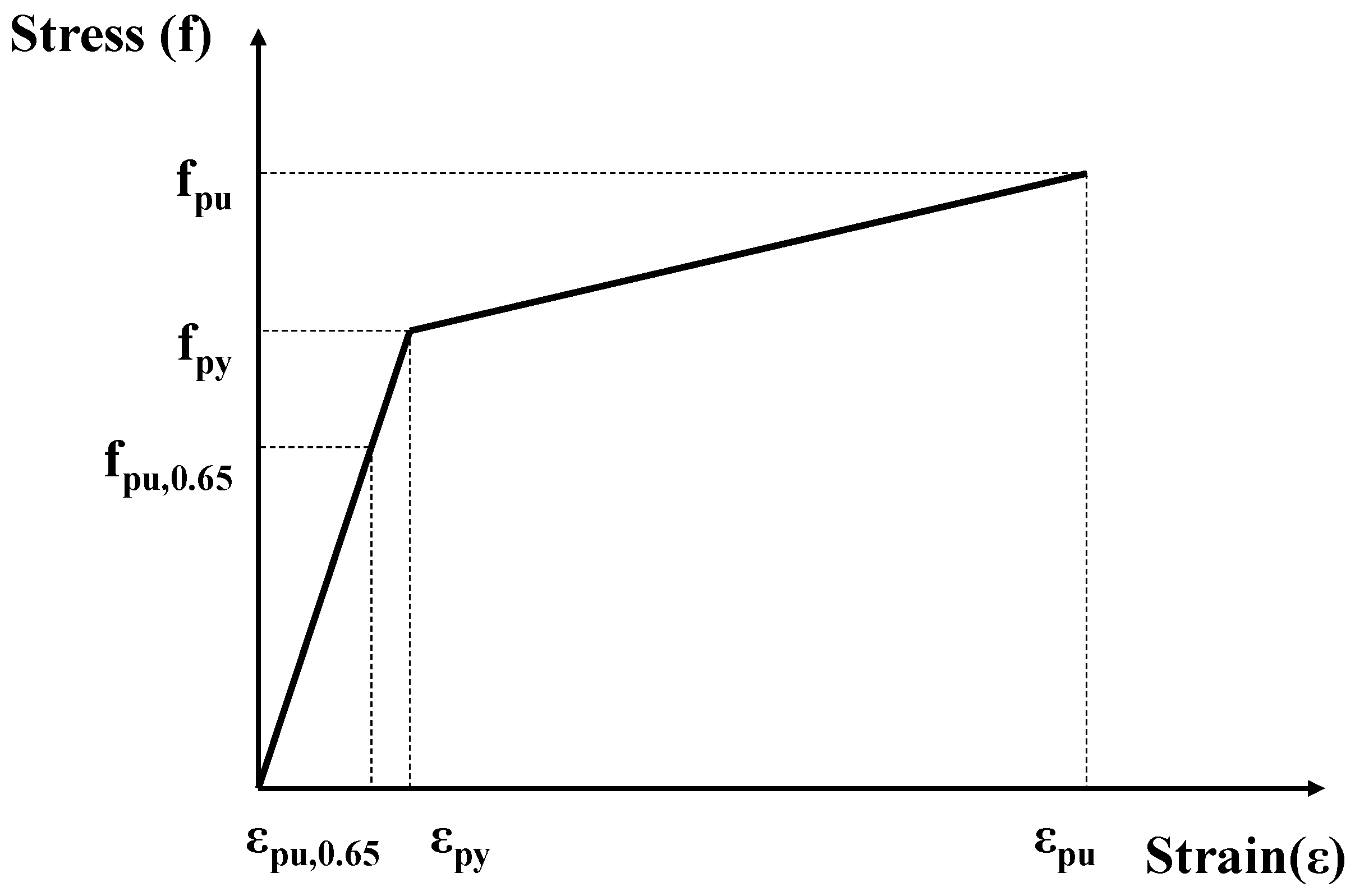


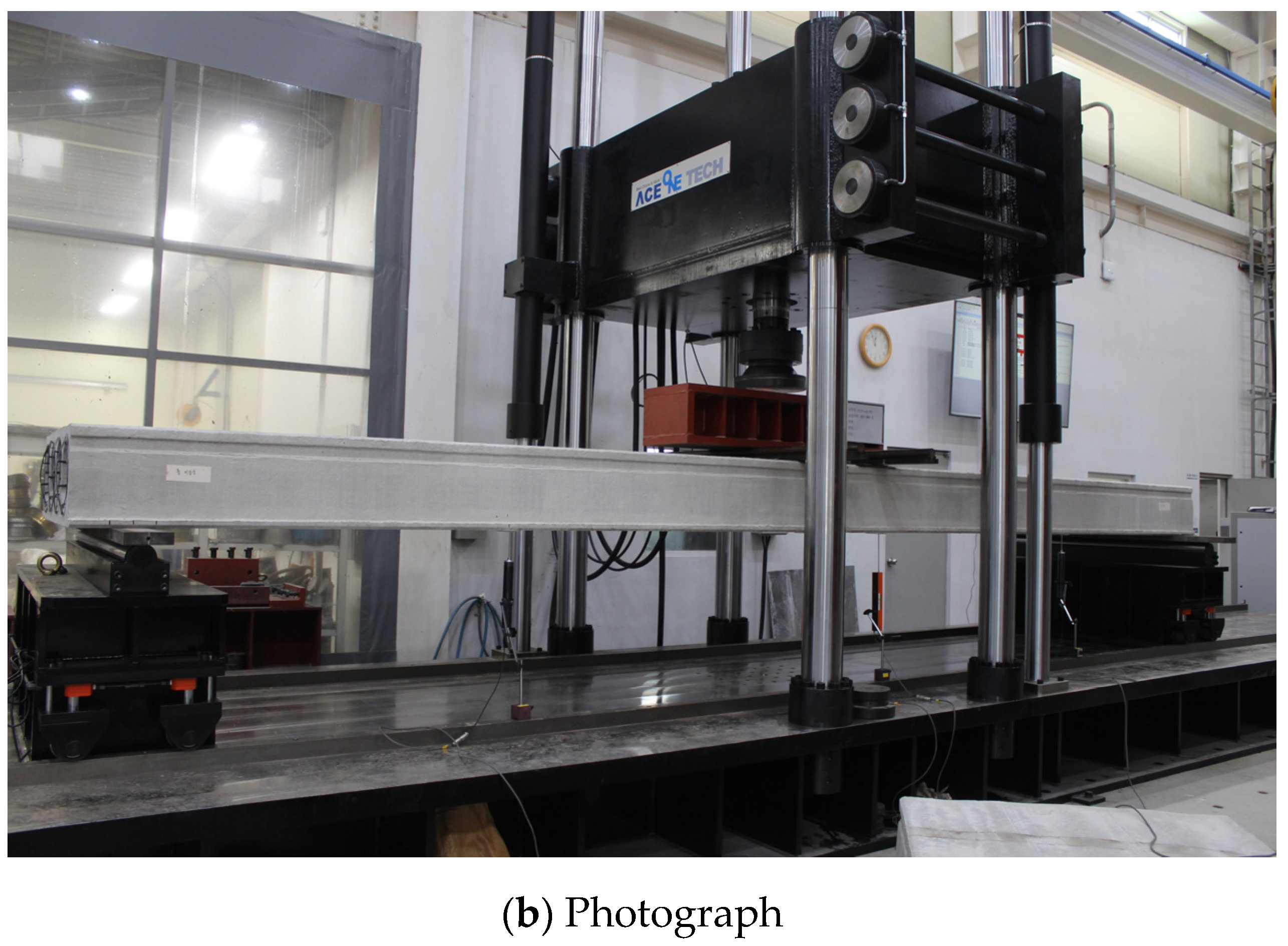

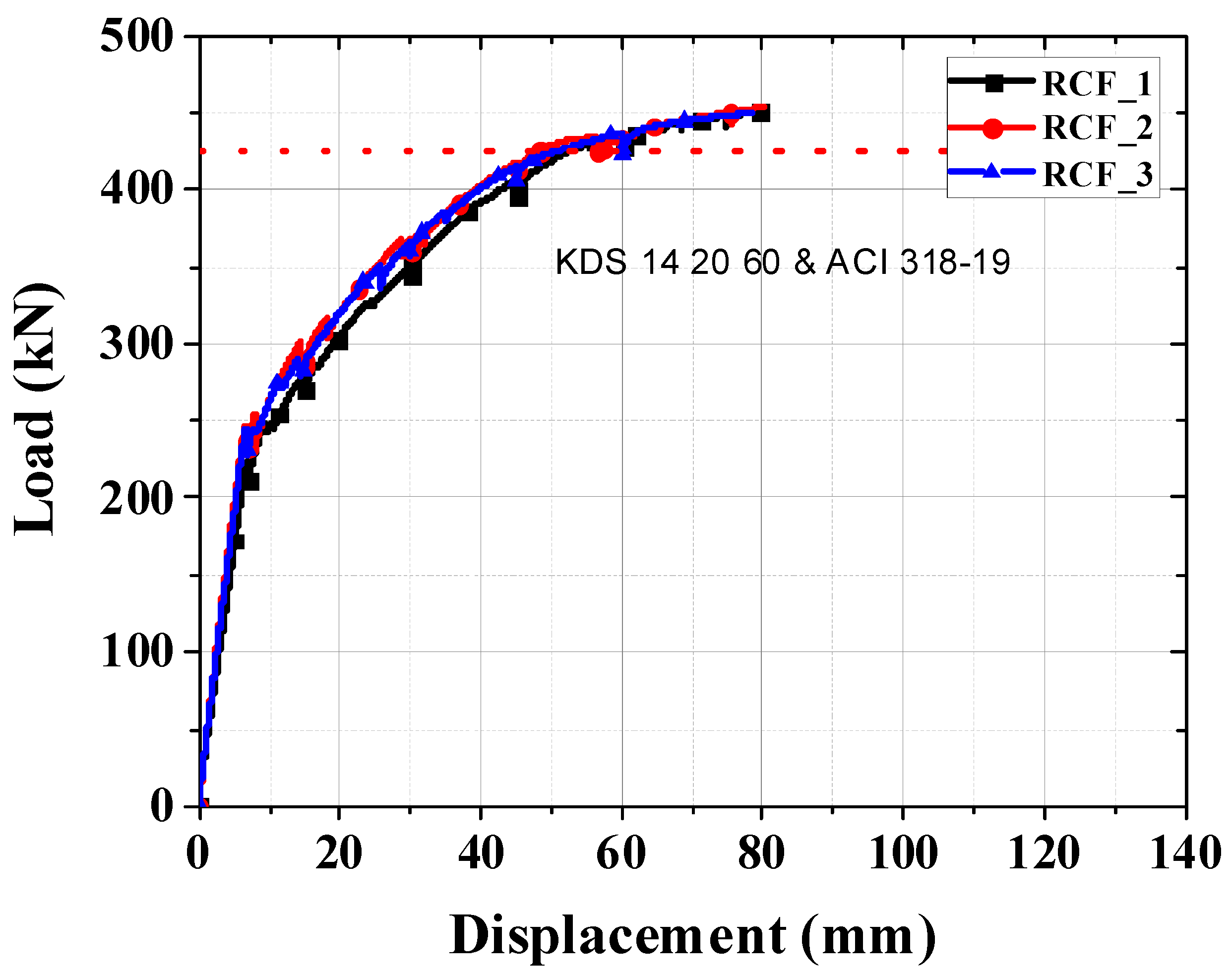
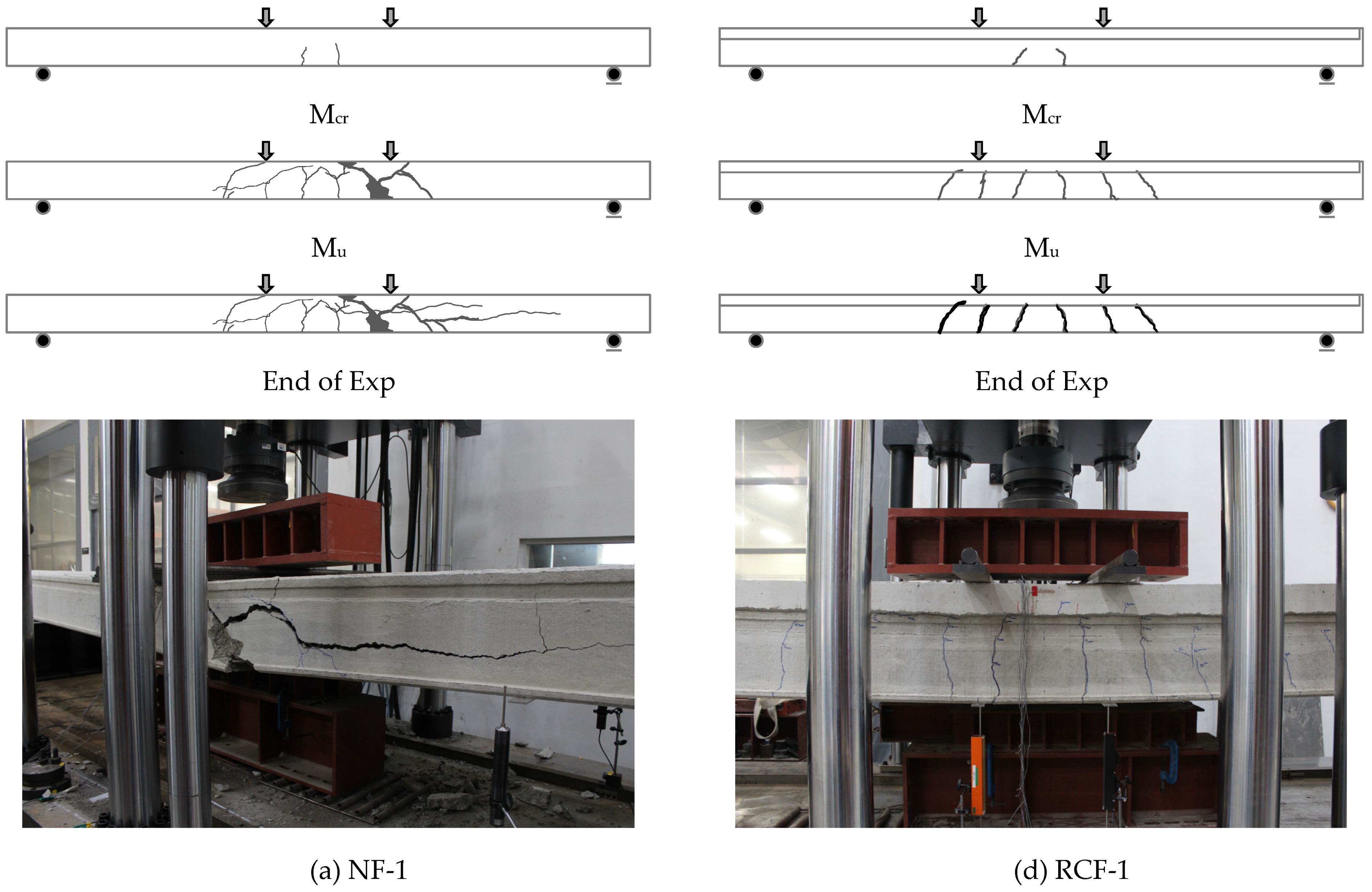

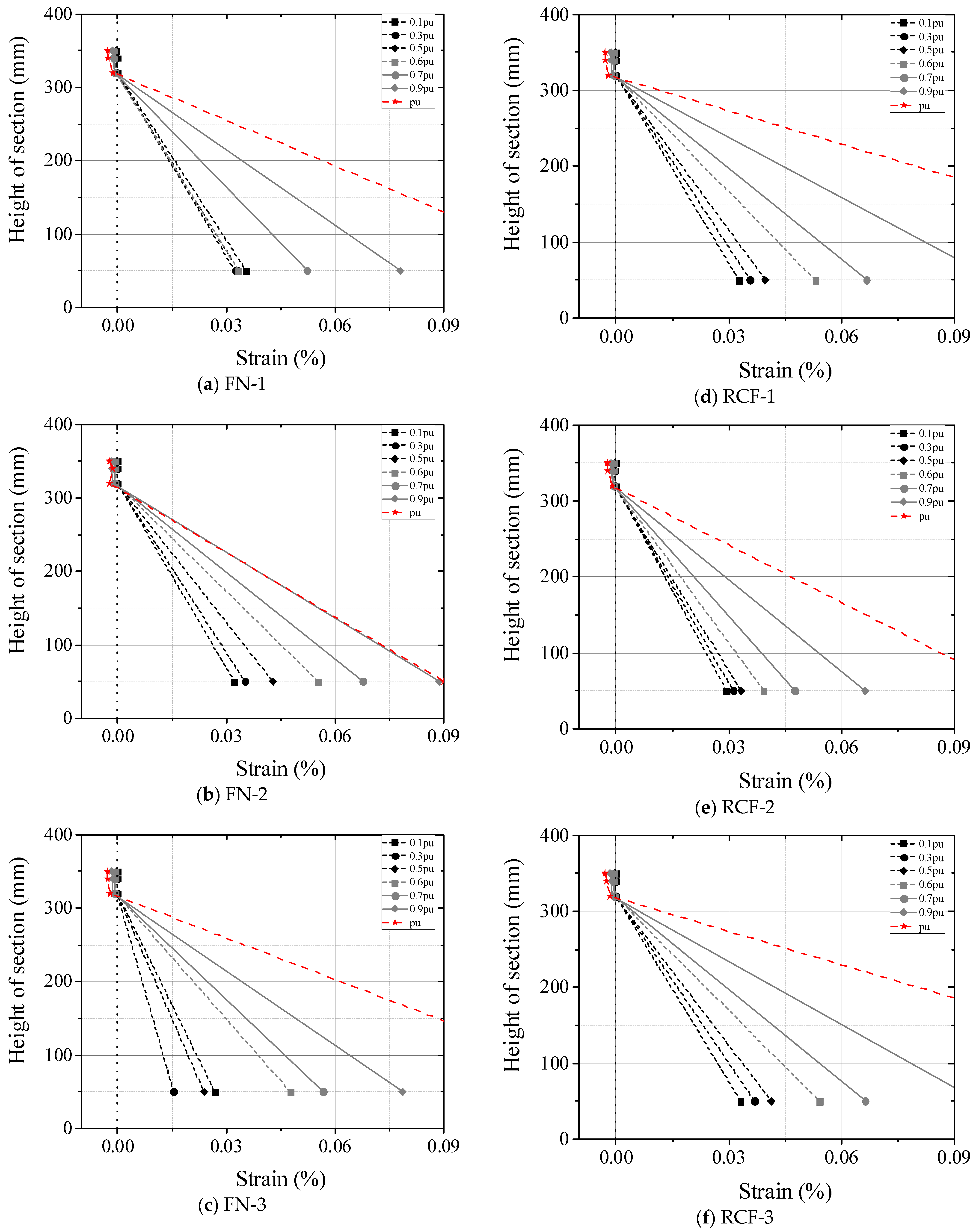
| Rating | Assumptions and Conditions for Interpretation | Assumptions and Conditions for Design |
|---|---|---|
| Non-cracking rating | -Assumption of planarity -Full adhesion of concrete and reinforcement (For Attachment Tensioners) -Given the material’s properties | -The material is elastic -No change in tension under working load |
| Partial crack rating | -Assumption of planarity -Full attachment of concrete and tensioner (For attached tensioners) -Given the material’s properties | -The material is elastic -No change in tension under working load |
| Crack rating | -Assumption of planarity -Full attachment of concrete and tensioning (For attached tensioning) -Given the material’s properties | -Ignore the tensile strength of concrete -Concrete fails when the compressive strain of the compression podium is 0.0033. -Use Equivalent Stress Blocks |
| fck (N/mm2) | W/B (%) | S/a (%) | Material by Weight (kg/m3) | ||||
|---|---|---|---|---|---|---|---|
| W | C | S | G | AD | |||
| 27 | 52.0 | 47.0 | 325 | 874 | 1000 | 2.6 | |
| 49 | 36.8 | 49.5 | 136 | 370 | 942 | 976 | - |
| HCS (N/mm2) | Synthetic Topping (N/mm2) | Note | ||||
|---|---|---|---|---|---|---|
| Design | Test | Ave | Design | Test | Ave | |
| 49 | 63.97 | 63.97 | 27.0 | 30.07 | 30.07 | Cylinder (φ100 × 200) |
| 48.21 | 30.24 | |||||
| 60.57 | 31.24 | |||||
| Specimens | f′c (N/mm2) | Size (mm) | Prestressing Strand | a/d (%) | H (mm) | ||||
|---|---|---|---|---|---|---|---|---|---|
| HCS | Synthetic Topping | h | b | l | Bottom | Top | |||
| FN-1 | 57.6 | – | 350 | 1200 | 7000 | 1012.7 | 29.5 | 10.0 | – |
| FN-2 | |||||||||
| FN-3 | |||||||||
| RCF-1 | 30.5 | 470 | 7.2 | 120 | |||||
| RCF-2 | |||||||||
| RCF-3 | |||||||||
| Specimens | Experimental Results | |||||||
|---|---|---|---|---|---|---|---|---|
| VCr (kN) | VCr ave (kN) | δCr (mm) | δCr ave (mm) | VPeak (kN) | VPeak ave (kN) | δPeak (mm) | δPeak ave (mm) | |
| FN-1 | 177.0 | 179.2 | 11.4 | 10.9 | 322.7 | 323.8 | 120.0 | 107.4 |
| FN-2 | 176.3 | 10.4 | 318.5 | 101.5 | ||||
| FN-3 | 184.4 | 10.8 | 330.2 | 100.7 | ||||
| RCS-1 | 216.9 | 229.3 | 7.1 | 7.0 | 451.4 | 451.7 | 80.1 | 77.9 |
| RCS-2 | 241.4 | 7.0 | 453.8 | 75.1 | ||||
| RCS-3 | 229.7 | 7.0 | 449.8 | 78.4 | ||||
| Specimens | Experimental Results | Analytical Results | Exp./Ana. | |||
|---|---|---|---|---|---|---|
| VCr (kN) | VPeak (kN) | VCr (kN) | VPeak (kN) | VCr | VPeak | |
| FN-1 | 177.0 | 322.7 | 181.3 | 317.4 | 0.98 | 1.02 |
| FN-2 | 176.3 | 318.5 | 0.97 | 1.00 | ||
| FN-3 | 184.4 | 330.2 | 1.02 | 1.04 | ||
| RCS-1 | 216.9 | 451.4 | 277.9 | 426.0 | 0.78 | 1.06 |
| RCS-2 | 241.4 | 453.8 | 0.87 | 1.07 | ||
| RCS-3 | 229.7 | 449.8 | 0.83 | 1.06 | ||
Disclaimer/Publisher’s Note: The statements, opinions and data contained in all publications are solely those of the individual author(s) and contributor(s) and not of MDPI and/or the editor(s). MDPI and/or the editor(s) disclaim responsibility for any injury to people or property resulting from any ideas, methods, instructions or products referred to in the content. |
© 2023 by the authors. Licensee MDPI, Basel, Switzerland. This article is an open access article distributed under the terms and conditions of the Creative Commons Attribution (CC BY) license (https://creativecommons.org/licenses/by/4.0/).
Share and Cite
Kim, D.-H.; Kim, M.-J.; Jo, M.-S.; Kim, H.-G.; Yoon, Y.-J.; Kim, K.-H. Evaluation of Flexural Behavior of Prestressed Concrete (PSC) Hollow-Core Slabs (HCSs). Buildings 2023, 13, 2869. https://doi.org/10.3390/buildings13112869
Kim D-H, Kim M-J, Jo M-S, Kim H-G, Yoon Y-J, Kim K-H. Evaluation of Flexural Behavior of Prestressed Concrete (PSC) Hollow-Core Slabs (HCSs). Buildings. 2023; 13(11):2869. https://doi.org/10.3390/buildings13112869
Chicago/Turabian StyleKim, Dong-Hwan, Min-Jun Kim, Min-Su Jo, Hyeong-Gook Kim, Yeo-Jin Yoon, and Kil-Hee Kim. 2023. "Evaluation of Flexural Behavior of Prestressed Concrete (PSC) Hollow-Core Slabs (HCSs)" Buildings 13, no. 11: 2869. https://doi.org/10.3390/buildings13112869






